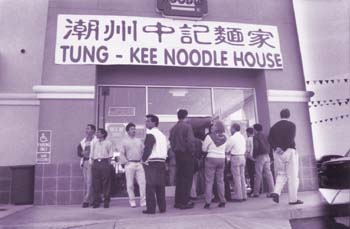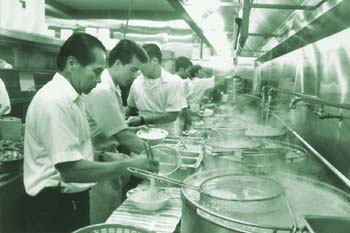McNoodles
People are catching on to Tung Kee Noodle Houses for a tasty and inexpensive bite
By Andrew X. Pham
CURIOSITY LURED me into Tung Kee Noodle House years ago. Swathed in ethnic flavors and configured for corporate efficiency, the restaurant appeared to be dishing up something unusual. The unbeatable prices and the ethnically diverse crowd impressed me, but it was the poster of a short-order cook flaming a wok that crystallized my first impression of the restaurant. His composure beamed not with the traditional joviality of poster chefs--his was the hard intensity of a fighter, a man out to carve his own empire. It was, I later discovered, the very face of Tung Kee Corporation's CEO, Mr. Tan Lu.
Tung Kee Noodle Houses are no strangers to the South Bay. The first restaurant, located on William Street in San Jose, flashed its red-and-green neon sign in 1983. The latest and greatest restaurant, the seventh, just opened last month on Barber Lane in Milpitas. Approximately 7,000 people turn to Tung Kee daily for quick, inexpensive bowls of noodles. Open every day, the chain serves nearly 50,000 meals a week. With a clientele composed of 50 percent non-Asian patrons, there is no doubt Tung Kee Noodle Houses have successfully made the giant leap into mainstream culture.
In the ethnic world of mom-and-pop diners, establishments survive by either serving authentic food in Spartan settings to a limited ethnic population or by catering to the mainstream with Westernized menus. Few restaurants find success in the middle of the road. So far, only Tung Kee Noodle Houses thrive in this no man's land, somehow tapping into not one but several groups of diners.
It all began with a Chinese-Vietnamese immigrant who neither spoke English nor had any restaurant experience. In 1978, Tan Lu, wife Anh Du and their four children fled Vietnam. Like many Vietnamese refugees at that time, they bought passage on an organized escape boat that was bound for Malaysia, a closer and safer destination than Hong Kong or Thailand. Their group of 36 made it to Malaysia, where they were granted political asylum.
The family spent one year in a Malaysian refugee camp, waiting to emigrate. Soon after the United States approved their applications, the family found itself transported from the stifling tropical heat directly into the punishing cold of Chicago. After a year of learning English, working at Togo's as a sandwich maker and saving prodigiously, Lu promptly took his family to sunny California.
Three more years of work yielded Lu and Du a modest savings. Although neither Lu nor his wife had any restaurant experience aside from his brief stint at Togo's, they borrowed and pooled all their savings to buy Tung Kee Restaurant at 261 E. William St. in San Jose. They believed the restaurant would give them a chance, albeit a dicey one, at being their own bosses and getting ahead. Despite its dilapidated condition, the restaurant was a good investment because they could live above the business and save on housing costs.
Hands-on Operation: A precise yet frantic energy pressurizes the cooking staff at any one of the busy Tung Kee Noodle House outlets.
The restaurant's former owners were in the business for a quick profit. They specialized in setting up and operating Chinese restaurants for a brief time to show that these businesses were profitable ventures. Then, as soon as possible, these professional entrepreneurs sold their businesses to recent immigrants who were not savvy about details involved in building a business from scratch. Usually, cooking instructions and management tips were thrown into the bargain to see the new owners through the transition period.
Lu and Du have worked hard since the first day. They labored seven days a week, year-round, a merciless drive that built a successful chain of seven restaurants in 13 years.
"It wasn't easy, but we worked hard and took it one step at a time," Lu says in a soft voice, sitting in his flagship restaurant on William Street. A small, compact man, soft-spoken and humble but intense, he wears the same uniform as his waiters, white short-sleeved shirt and navy blue slacks. Pens line his shirt pockets, and a cellular phone clips onto his belt. His hands always carry a notebook organizer.
About the restaurant's name, Lu confesses, "Tung Kee doesn't mean anything. There's no one named Tung Kee. It's just a word. It was the name of the restaurant when we bought it." To avoid losing the customer base and filling out paperwork, they simply kept the name.
"We went carefully," he confides, "and watched what other successful people were doing because we were new to the restaurant business. We could have opened the second and the third restaurant a long time before we did, but we just waited until our customers demanded it. Our restaurant became so crowded that we had to open another restaurant or lose the business to someone else."
Already competition has come from unexpected quarters: the New Tung Kee Noodle Houses (a fast-growing chain of three restaurants), whose owners are former business partners and relatives of the family. The Tung Kee formula seems to be so successful that New Tung Kee Noodle Houses are spitting image of the originals--and equally successful. The familial faction took with them the restaurant name as well as the business formula. And since those involved are relatives, the families decided not to drag each other into court on infringement charges, but instead remain on non-speaking terms.
Customers, both the dine-in and takeout crowds, are often confused by the two chains, requesting items that one chain has and not the other. New Tung Kee expanded the original menu and offers five more entrees, including a vegetarian dish and even a version of pad Thai noodles. What the new chain lacks are the corporate posters depicting the rise of the family corporation, with photos of various restaurants. But everything else remains the same: the Chinese-Vietnamese waitstaff, the neon signs, the neutral dining-room color scheme, the customized kitchen layout, the Formica tables and indestructible benches.
The two chains are so similar that the Tung Kee Corporation has commissioned a new logo to distinguish itself. And what else should this one resemble but the corporation that Mr. Lu holds in high esteem: McDonald's. The new logo is a gold noodle bowl against a red square.
Like McDonald's, the Tung Kee menu forms the backbone of the chain's success. Dishes are common entrees, familiar and accessible to a large segment of both Asian and non-Asian diners. Noodle soups--the biggest sellers--reach a broad spectrum because the broth, unlike other Asian soup broths, is bland, with only traces of Chinese herbs. The moderation of flavors is tolerated by Asian diners and accessible to non-Asians.
Most entrees come in two sizes, small and large. The small size is generous; the large size can serve two. The choices are comprehensive: rice noodle in beef stew ($2.75, No. 7), wonton noodle soup ($3.50, No. 9), rice vermicelli duck curry soup ($2.50, No. 13), rice porridge ($2.50, No. 20) and various stir-fry dishes over rice. Prices are unbeatable: 12 of the 30 items cost $2.50, nine items are $2.75 and nothing peaks over $4. A pot of hot tea comes with every order. Sodas are cheaper here than at vending machines, and Heineken beer goes for $1.50 a bottle.
Tung Kee achieves these rock-bottom prices through streamlined operations and rigorous cost control. The efficiency-driven corporate ideology is most visible in the kitchens. Although the actual setups vary slightly, all Tung Kee kitchens employ the same implements: three cauldrons, specially designed imports from Hong Kong, form the heart of the entire establishment. Two hold soup broth, and one boils water for blanching noodles and vegetables. One single wok, set over extremely high flames, cooks all the stir-fry dishes and crispy noodles. One large pan fries all the sensitive ingredients the wok can't handle. Besides these, a large rice cooker and a industrial-size water boiler for tea provide all the assistance necessary to service the whole restaurant.
A certain precise yet frantic energy pressurizes the kitchen, exciting motion among the cooks and sending the waiters ricocheting out into the dining room bearing steaming trays of food. The process, from receiving orders to handing back steaming platters of food, is carefully orchestrated.
Lu says he intends to keep the prices the same "forever." He insists, "We have not raised our prices in the 13 years since we first opened. We'll become more efficient--whatever it takes."
In the newest restaurant, the waitstaff will take orders on palm-top computers with wireless links to a central computer. This saves staff the time it usually takes to re-enter their orders into a touch-screen ordering computer--thereby eliminating one major bottleneck. The central computer sends the orders to monitors in the kitchen, prints the receipts, tracks the orders at the cash register, logs the transactions in the database, tracks inventory with the updated data, reports back to the head corporate computer, and performs several other managerial and accounting tasks.
Lu wants to continually push the operational envelope to save thousands of work-hours, an effort that he hopes will win Tung Kee an ever-growing clientele. Although Lu is 53 and his wife is 48, they still work 10 hours days and have no intention of slowing down or moving from their renovated living quarters above the restaurant. Du manages the restaurant on William Street and handles the cash register most of the opening hours. Lu makes his rounds to the warehouse and to all the restaurants every day and often fills in as a cook when one of his kitchen hands calls in sick.
"Besides," Lu says, "if we slow down, we'll fall behind. Things are going well. We'll keep going hard. When we quit, we quit and sell everything. There's no slowing down. People will catch up [to us]."
Judging from their growing popularity as the alternative Chinese fast food that does not serve steam-table fare, people are catching on to Tung Kee Noodles Houses, and catching up for a quick, tasty and inexpensive bite.
[ Metro | Metroactive Central | Archives ]
This page was designed and created by the Boulevards team.

Christopher Gardner
Christopher Gardner
From the November 14-20, 1996 issue of Metro
Copyright © 1996 Metro Publishing, Inc.
![[Metroactive Dining]](/dining/gifs/dining468.gif)